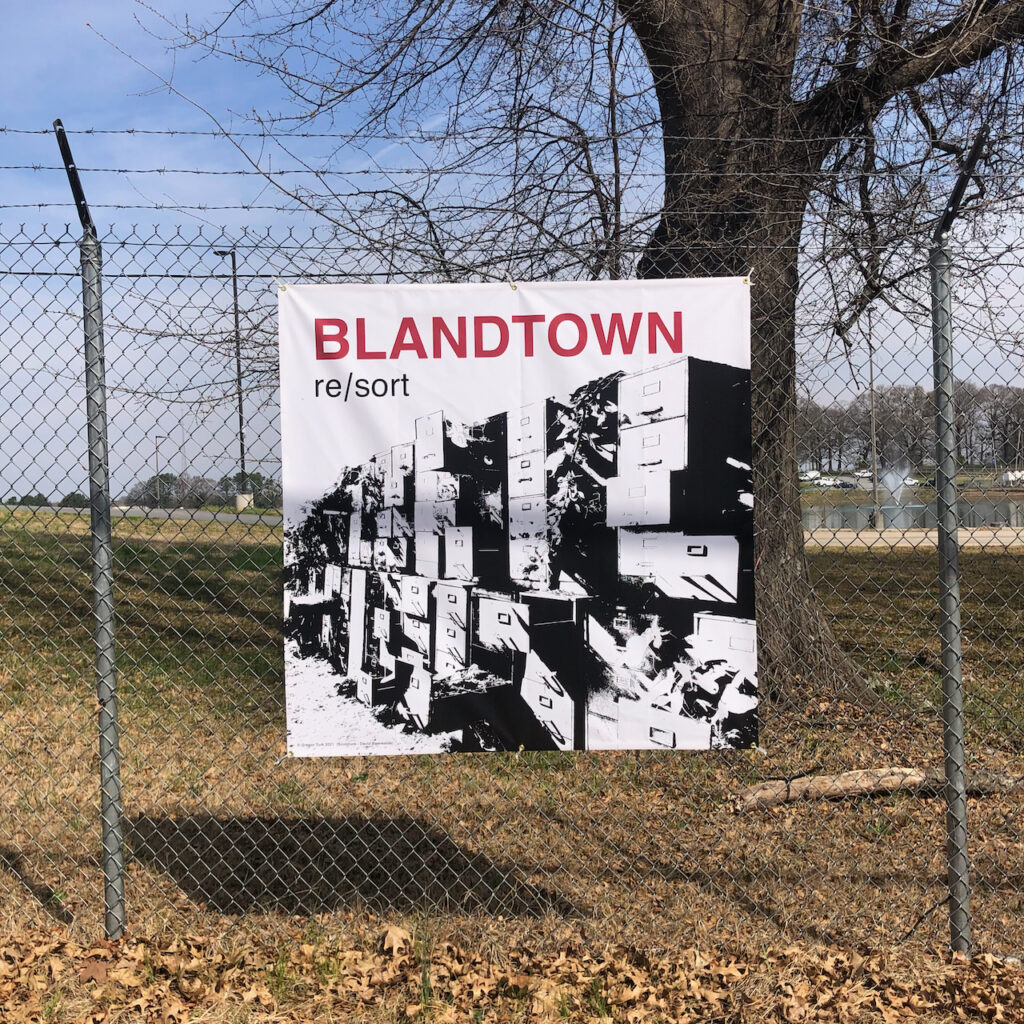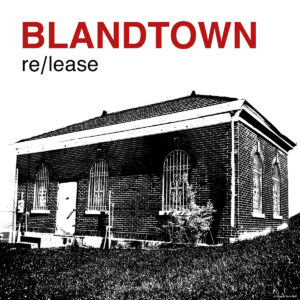Blandtown Banners
Blandtown, Atlanta, Georgia, March 10 – May 7, 2021
The Agitprop banners are displayed along the Watershed Reservoir fence on Howell Mill Road and Huff Road in Blandtown on Atlanta’s westside.
Blandtown Banners features high-contrast photographs of Blandtown landmarks (former and remaining), infrastructure, and new construction projects that are accompanied by a word with the prefix “re”, offering up multiple interpretations through wordplay. Placed where traffic frequently backs up, my intent is to prompt a dialogue with viewers on Blandtown: its history, rapid development, and future.
This program is supported by the City of Atlanta Mayor’s Office of Cultural Affairs through a Neighborhood Arts Grant in collaboration with the Upper Westside Improvement District, Blandtown Neighborhood Association, and the City of Atlanta Department of Watershed Management.
![]()





Re/Collect
The Temple of God is now only a memory or recollection. “Collect” references both a short prayer and the gathering of people. Formerly located 1353 Boyd Avenue, Georgia Power purchased the church 2012 and razed it in early 2013. The church’s foundation included the Little Bethel AME Church 1921 cornerstone and The Greater Bethel AME Church 1940 cornerstone. The 2011 image I used was taken by and used with permission by Terry Kearns.

Re/tell
This banner features a 1936 photograph taken by Wilbur Kurtz of Sarah Huff in front her family home. In 1855, her father, Jeremiah Huff, built the house atop an existing 1830’s log cabin. Occupied by both Confederate and Union forces during the Civil War, it survived the war and later became Atlanta’s oldest existing house. In 1954, the 99-year-old house was unceremoniously bulldozed, burned, and plowed into the ground under the direction of Mary Rushton to build a factory. The Rushton Toy Factory was in turn razed in 2008 to make way for Apex West Midtown apartments. So as to the wordplay: “retell” refers to amateur historian Sarah Huff’s memoir My 80 Years in Atlanta and “tell” references the archaeological term of a mound built up from the debris of accumulated refuse from generations of settlement on the same site.

Re/tire, Re/Claim, re/solution
Re/tire, re/claim and re/solution allude to the changing land usage in Blandtown. Once a thriving African American community surrounded by railroads, stockyards, and fertilizer plants, the neighborhood was rezoned to industrial in the 1950’s. “Re/tire” features an image of the Liberty Tire Recycling facility on Huber Street and “re/claim” features Sand-Rock Transit on Huff Road. As the neighborhood returns to more residential zoning, what will become of these industries, will they retire or stake their claim?



re/settlement, re/construction, re/trench, re/tract, re/doubt
The five banners emblazoned with the words re/settlement, re/construction, re/trench, re/tract and re/doubt raise deliberate questions and/or make pointed comments on recent housing developments in the neighborhood. With well over 200 working-class homes, the neighborhood was undermined in the 1950’s with racist zoning practices that caused a precipitous decline. Since 2016, only 4 of the original houses remain. For the banners with the words “resettlement” and “reconstruction” I combined images of Brock Built’s West Town, a development of single-family homes located in the center of the former residential core. The imposing wall built behind the Apex West Midtown apartments plays off the meaning of “redoubt” being a fortress-like structure and simultaneously being undermined by being labeled in “doubt”. “Retract” features an image of the future site of Minerva Homes’ Hayden Westside demarcated and stubbed with vertical pvc pipes. In a later image of the same site, a trench appears in the foreground referencing both the ditch and the reduction, or retrenchment, of the original neighborhood.





re/stock
“re/stock” Back in the day this neighborhood was home to several meat processing plants including Star Provisions and White Provisions near Huff Road and Howell Mill. Down Huff towards the far end of Fairmont was a rendering plant, Atlanta Tallow Company. Livestock carcasses were transported between the two locations through the residential community of Blandtown. Dead animals collected throughout the city were also brought here, including an alleged elephant that died while the circus was in town. Fluids dripped onto the streets of English, Culpepper, and Boyd, making strong odors during the summer months that residents had to hose down. The banner with “re/stock” references the role livestock once had in the area. This image features Brock Built’s West Town Phase II residential development where the rendering plant once was located. This development is now restocking the neighborhood of single family homes. Of the hundreds of razed Black-owned houses that formerly made up Blandtown only 4 remain. Blandtown Banners features high-contrast photographs of Blandtown landmarks (former and remaining), infrastructure, and new construction projects that are accompanied by a word with the prefix “re”, offering up multiple interpretations through wordplay. Placed where traffic frequently backs up, my intent is to prompt a dialogue with viewers on Blandtown: its history, rapid development, and future.

re/sort, re/collect, re/cover
Three of the banners feature images taken at the Goat Farm at the end of Foster Street in Blandtown. The first image is of David Baerwalde’s file cabinet installation that was located there for 7 years. Created for the Hambidge Center’s 2014 Auction and facilitated in conjunction with The Nature Conservancy, the installation was removed by the artist earlier this year. Baerwalde discovered (or rediscovered) the file cabinets in the GF warehouses laden with decades worth of detailed plans, ledgers, catalogues, personal documents and daily records dating back to when the the GF was the E. Van Winkle Gin and Machine Works which produced cotton-related machinery and later the Murray Mill which during WWII manufactured ammunition. For Baerwalde’s installation, the file cabinets were moved outside and stacked with several of the drawers purposefully left open and planted with native southern species. “Sort” obviously alludes to the filing cabinets, but “resort” is more subtle. Future redevelopment of the GF will include a boutique hotel along with a museum (MOCA-GA) and other high-end establishments, making it a resort of sorts. (Thank you David for permission to use an image of your installation for a banner.)
An image of one the GF’s vine clad buildings is used in the banner with “re/cover.” And “re/collect” features the GF’s iconic water tower. 


re/place, re/sist, re/settlement
The re/place and re/sist banners feature images of my studio located on English Street, just off Huff Road. Built in the late 1940’s by Johnny Lee Green for $2,000 in material costs which included concrete blocks, culled bricks, and salvaged wood, he and his wife Dorothy raised their 5 children in this 960 s.f. house. Re/place (showing the expanse from the back of the studio) was taken around 2008 before the few remaining original Blandtown homes were razed. In 2016 Brock Built began construction of 45 new homes dubbed West Town Phase I (same view but from a different vantage point can be seen in the “re/settlement” image). This modest structure became what is known as a nail house. (A nail house comes from a Chinese term that translates literally as “nail household” and refers to a property that is a holdout from a larger real estate development, like a nail that can be neither removed nor hammered down.) “Re/sist” shows a closer view of the back of the studio and vegetable garden surrounded by what are now $800,000+ homes.



re/source, re/lease
For this installment on specific banner descriptions, I offer up images of the Department of Watershed Management’s facility upon whose fence the banners are displayed. The western half of the plant is located in Blandtown with the eastern half in Berkeley Park. The image depicted with the word “re/source” was taken by drone and used with permission by Blandtown resident, Scott Lovett. It shows part of Reservoir #1 and much of the Hemphill Water Treatment Plant. Originally constructed in 1893 the plant has expanded numerous times and currently supplies roughly 65% of all drinking water consumed by Atlantans. The image with “re/lease” depicts the diminutive brick Valve House on Howell Mill Road (seen behind the banner), which used to control reservoir levels prior to the construction of Reservoir #2.

re/vise
Traffic is Blandtown’s fate. For my final post on individual descriptions of the banners I examine “re/vise” which features an image of Huff Road (all one mile of it) at a complete standstill, which happens several times a year. The need to “revise” the neighborhood’s traffic situation is an understatement. This gripping, ongoing “vise” is the result of unbridled development in Blandtown. Scheduled for June, Crescent Communities will fell hundreds of trees on 10 acres on Fairmont to build 340 apartments dubbed Novel West Midtown. Empire Communities currently constructing 69 townhomes at 912 Huff (Empire Crosby), will build another 179 condos along a 3-block stretch on Huff (Empire Longreen). At the Goat Farm, Tribridge Residential is slated to build 175 units and Tungsten Partners will build a 125-room boutique hotel. Brock Built’s West Town Phase 2 (75 houses), Hayden’s Westside (34 units), and Chelsea Westside (92 units) are all currently under construction And as of last month, SH Bernstein & Co. is seeking approval of a 9 story +/-200 unit next to the strip joint on Blandtown’s western edge on Marietta Blvd. With almost 1300 new units, the “vise” will surely tighten.
For more Blandtown content, visit Blandtown ATL.